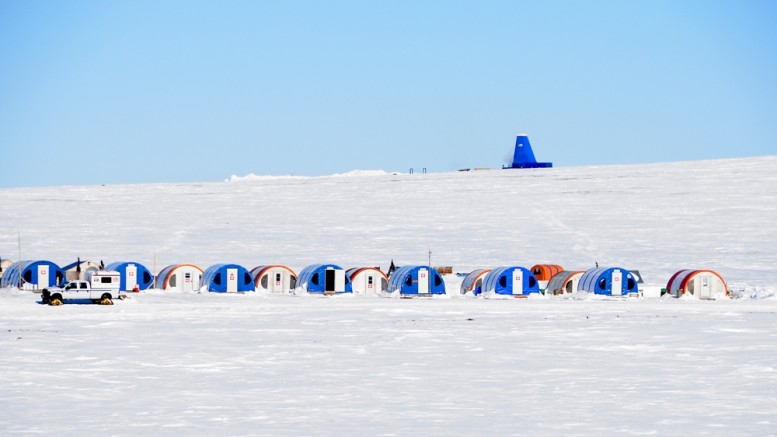VANCOUVER — Peregrine Diamonds (TSX: PGD; US-OTC: PGDIF) hopes to have its Chidliak discovery producing within five years, and it outlined the path forward on July 7 with a preliminary economic assessment (PEA) on the CH6 and CH7 kimberlite pipes.
Chidliak sits 120 km northeast of Iqaluit, the capital of Nunavut, on Canada’s Baffin Island. Peregrine has uncovered 74 kimberlites on the property since 2008, but its start-up operation would focus on what it calls the Southern Priority Area, due to better tonnage potential and coarse diamond distributions.
Peregine’s first phase of development would involve a decade-long open-pit diamond mine, with $435 million in development costs. The operation would focus on CH6 and transition to CH7.

Hélicarrier’s A-Star 350B3 and the Nolinor 767 at Peregrine Diamonds’ Chidliak diamond camp on Baffin Island during a bulk sampling program in 2015. Credit: Peregrine Diamonds.
“We’re looking at one of the highest margin diamond-development projects in Canada since the discovery of the Lac de Gras district,” president and CEO Thomas Peregoodoff said during a conference call. “And beyond that first phase we’re looking at significant exploration potential. We can now look at the discovery package from more of a brownfield perspective, which may very well change the outlook on kimberlites across the property.”
The PEA is based on twin resources released earlier this year. The CH7 estimate includes 5 million tonnes grading 0.85 carat per tonne for 4.23 million contained carats, while CH6 hosts 4.6 million tonnes grading 2.45 carats per tonne for 11.39 million contained carats. Phase-one resources total 9.6 million tonnes at a life-of-mine head grade of 1.67 carats per tonne for 15.62 million contained carats. Both resources extend to 250 metres deep.
“There are a couple aspects of the diamonds themselves that drive our valuation. First, there is the colour distribution that is dominated by white and off-white stones … those are the high-value product,” Peregoodoff continued.

A selection of diamonds from the CH-7 bulk sample (unit KIM-4) taken at the Peregrine Diamonds’ Chidliak diamond property on Baffin Island. The largest stone is 5.33 cts. Credit: Peregrine Diamonds.

Selection of eight diamonds from Chidliak’s CH-6 bulk sample Batch C. The largest stone weighs 8.87 carats, the smallest is 0.22 carat. Credit: Peregrine Diamonds.
“If you compare this parcel to run-of-mine parcels at other operations in Canada, you’d see a colour distribution that is essentially reversed. The second element of our stones is the shape. Our diamonds have a lot of nice, octahedral shapes … it speaks to the yield of the stones when they’re cut,” he added.
The PEA was prepared by JDS Energy & Mining and features a $471-million, after-tax net present value at a 7.5% discount rate, and a 29.8% internal rate of return. The operation would produce 1.2 million carats annually, with production peaking at 1.8 million carats per year.
Peregrine says that Chidliak would generate a 72% operating margin, with pre-tax average annual free cash flows of $131 million. The company’s five-year time line to production assumes feasibility-level scoping work next year, while permitting would conclude in time for development in mid-2019. The construction schedule would see the mine enter commissioning, and then production, in 2021.
“The Nunavut government’s approach to mining is clear: they support responsible development, and understand that to achieve devolution they need an economic foundation. I believe they see resources as a pillar in becoming an independent territory,” Peregoodoff said.

Canada’s Baffin Island near Peregrine Diamonds’ Chidliak property. Credit: Peregrine Diamonds.
“We’re a bit different in terms of water compared to other diamond developments in the North, since we do not need to drain any lakes to proceed with the plan … from a wildlife perspective there are also not any major caribou herds in the area where we work.”
Caribou became a hot-button topic in the territory after the Nunavut Impact Review Board rejected Sabina Gold and Silver’s (TSX: SBB; US-OTC: SGSVF) mine design for its Back River development due to concerns for the regional Bathurst herd.
Peregrine’s PEA includes a cost-benefit analysis on whether to build an all-weather road into the property. The alternative would be a seasonal road that would be open for six weeks during late winter.
“The transportation corridor is critical infrastructure for both construction and operations,” Peregoodoff said. “A lot of people are familiar with Canadian diamond operations that are supported by winter roads that extend to Yellowknife. It’s important to understand that Chidliak and Baffin Island are not the Lac de Gras region. When we balanced off risk involving weather and working conditions, the all-season road was definitely the way to go.”

A cargo plane take off from Peregrine Diamonds’ Chidliak diamond project. Credit: Peregrine Diamonds.
The company concludes that the best option is a 160 km road from Iqaluit, but it would eat up 30% of Chidliak’s preproduction capital. There is $107 million earmarked for site development and roadworks on a 100% basis, and Peregrine could get infrastructure funding from the federal government.
The company’s shares have traded in a 52-week range of 9¢ to 31¢ per share, and closed at 22¢ at press time. Peregrine has 339 million shares outstanding for a $74.6-million market capitalization, and reported $5.7 million in working capital at press time. Robert and Eric Friedland hold 46% of Peregrine’s outstanding shares.


Be the first to comment on "Peregrine eyes first production at Chidliak by 2021"